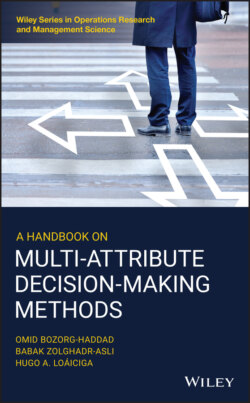Читать книгу A Handbook on Multi-Attribute Decision-Making Methods - Omid Bozorg-Haddad - Страница 18
2 Simple Weighting Methods: Weighted Sum and Weighted Product Methods 2.1 Introduction
ОглавлениеTo reach a better understanding of any decision‐making problem, one must employ information‐gathering methods, including but not limited to surveys, questionnaires, examination, and sampling, to collect as much practical information as possible. Eventually, such attempts increase the chance of choosing the most suitable alternative, that would better reflect the needs and interests of the stakeholders of the MADM problem at hand (Tzeng and Huang 2011).
From the MADM point of view, the gathered information regarding the problem in question is generally represented in a matrix form, commonly referred to as the decision‐matrix. Based on the decision‐matrix, the decision‐maker can anticipate the stakeholders' desires and preferences, which eventually lead to choosing the most suitable available option through a mathematically supported framework. The choosing process proceeds and their assumptions are what distinguishes between the MADM methods.
A MADM problem is composed of a set of alternatives, which are the feasible discrete solutions available to the decision‐maker, and a set of evaluation criteria, which are the instruments through which the stakeholders describe their objective. Subsequently, a decision‐matrix in extended form is constructed based on the four following information sets (Yu 1990):
1 (1) The set of feasible alternatives, denoted by {ai | i = 1, 2, …, m}. Notice that each alternative represents a row in the decision‐matrix (D);
2 (2) The set of predefined evaluation criteria denoted by {cj | j = 1, 2, …, n}. Each criterion represents a column in the decision‐matrix (D);
3 (3) The anticipated value or performance of the alternatives with regard to each given criterion. Let v(i,j) represent the value of the ith alternative with respect to the jth criterion, then a m × n matrix is constructed with v(i,j) as the elements; and
4 (4) The decision‐maker prioritizes based on the weights, denoted by {wj | j = 1, 2, …, n}. Each wj reflects the importance of the ith criterion. This step involves a weighting procedure.
Consequently, the decision‐matrix (D) is represented as follows (Yu 1990):
(2.1)
In addition to the decision‐matrix on occasion, the decision‐makers define extreme alternatives, namely, ideal (a+) and inferior (a−) alternatives. The ideal alternative is an arbitrarily defined vector of choices describing the aspired solution to the given problem, which, in practice, may or may not be achievable. The inferior alternative is a solution that represents the most undesirable option for the given MADM problem. There are two main methods to compose the ideal and inferior alternatives. One can use the best and worst values in the jth column of the decision‐matrix to compose the jth component of the ideal and inferior alternatives, respectively. On the other hand, one could also use the upper and lower boundaries of the feasible range of the jth criterion to compose these arbitrarily defined alternatives. In such cases, if the criterion is considered to be positive, where the larger the value the better the situation, the upper and lower boundaries represent the ideal and inferior alternatives, respectively. Conversely, a negative criterion, where the smaller the value, the better the situation, the lower and upper boundaries represent the ideal and inferior alternatives, respectively. These arbitrarily defined alternatives can then be represented as follows (Tzeng and Huang 2011):
(2.2)
(2.3)
in which and = the components of the ideal and inferior alternatives with regard to the jth criterion, respectively.
The admissibility of each alternative in a MADM problem hinges on their performances with regards to the predefined evaluation criteria, which may be of different mathematical nature. In fact, an MADM problem commonly involves multiple criteria with different dimensions and measure of scales. One of the main challenges of the MADM is for the decision‐maker to aggregate the performance of alternatives with regard to each given criterion so that the overall preference of alternatives can be achieved. However, the former cannot be achieved while the evaluation criteria are not of the same dimension, measuring unit, and scale. Consequently, through a mathematical procedure, better known as normalization, the decision‐matrix is transformed into a dimensionless matrix. There are various normalization procedures, such as the Z‐score transformation; yet, the following two forms are the most recommended for MADM problems, mainly, because they are easy to interpret (Ebert and Welsch 2004; Zhou et al. 2006; Tzeng and Huang 2011):
Form I: This normalization process, linearly, transforms all the performance values, so that the relative order of magnitude of the ratings remains equal. The procedure can be set up as follows (Chang and Yeh 2001):
For positive criteria:(2.4)
For negative criteria:(2.5)
in which r(i,j) = the normalized performance value for the ith alternatives with respect to the jth criterion.
Form II: In this normalizing procedure, which is slightly more advanced than the former technique, both ideal and inferior alternatives are used to normalize the performance values, as follows (Ma et al. 1999):
For positive criteria:(2.6)
For negative criteria:(2.7)
The cited normalization procedure yields dimensionless performance values of the decision‐matrix in which the [r(i,j)] range between 0 and 1.
Through the normalization procedure, the decision‐maker transforms the elements of a decision‐matrix into commensurable values. The next step is for the decision‐maker to combine these values in a way that the alternatives’ overall preferences can be evaluated. Herein, assume that the decision‐maker evaluated the importance of each criterion and derive the set of weights that best reflect the stakeholder’s priorities. Let wj denote the assigned weight to the jth criterion; the following holds for the assigned weight set:
(2.8)
Assigning the proper weight to each criterion is a challenging procedure that is discussed later in the appendix section. The challenge remains, however, on how these values can be combined to form an overall preference for each given alternative. Sections 2.2 and 2.3 describe, in detail, two basic methods to aggregate the alternatives’ performances and obtain the alternatives’ overall preference.
